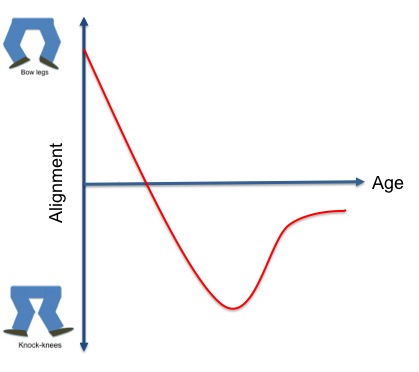The contour of a leg as one looks at it from the front or back is called its “alignment”. It is formed by the angle between the thigh bone (femur) and the leg bone (tibia). The alignment of a child’s legs can cause their parents much anxiety, especially if well-meaning friends and relatives keep commenting on them as being abnormal.
People generally talk about bow-legs (where the knees bow outwards), or knock-knees (where the knees come in together).


It is important to realise that the alignment of a child’s legs varies with their age, and that it usually follows a specific pattern of growth and development. Bow-legs are normal at a certain age, as are knock-knees. The graph below shows how the alignment changes with age

Generally:
- At birth, babies’ legs are very bowed, (but often this is not noticed).
- When babies begin to stand and walk, parents and others often notice the bowing
- The bowing continues to improve with growth, and the legs usually straighten at around the age of two years
- The legs then continue to develop, with the knees continuing to grow inwards, producing a knock-knee appearance.
- Knock-kneeing is at its worst when the child is 3-4 years old
- The knees then start to come back out, producing the normal adult alignment by around age 6-7.
Treatment
The first decision that has to be made is whether the alignment of the legs is appropriate for your child’s age (“physiologic”). If it is, then it is just a case of watching and waiting to see whether the legs follow normal development,
Occasionally, bow legs can persist longer than normal, (beyond 3 years’ age), and can become progressive; such cases need closer observation, and occasionally surgery.
If the alignment is not in keeping with the child’s age, further investigations (x-rays, blood tests) are needed to see whether there is a cause for the abnormality. Occasionally, problems with Vitamin D, hormones or the kidneys can cause problems with alignment of the legs.
It is important to correct severe bow-legs or knock-knees as the uneven distribution of mechanical forces in the knee joint can lead to osteoarthritis at a later age.
There is usually no role for splints, orthotics or braces in the treatment of bow-legs or knock-knees - they do not make any difference.
If there is a deficiency of a Vitamin or hormone, it is important that this is corrected.
Surgery to manipulate the growth of the bones, or to break and re-set them in the correct position, maybe required, but generally not until the age of 5-6 years.

